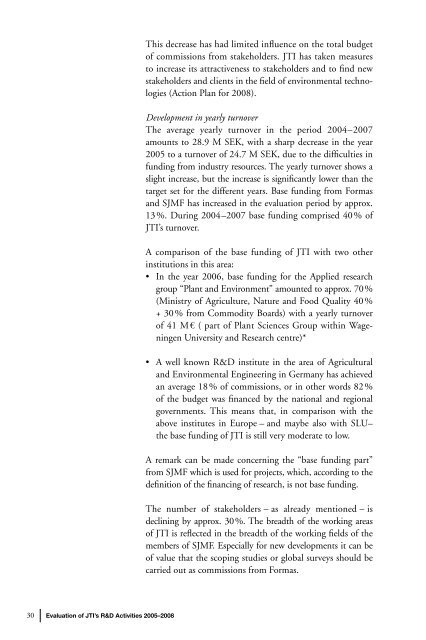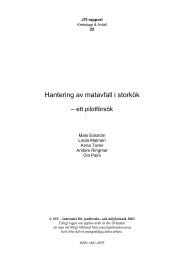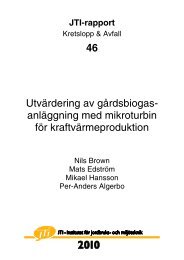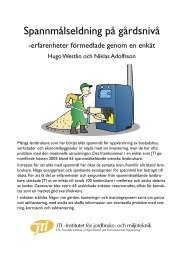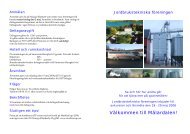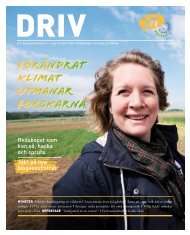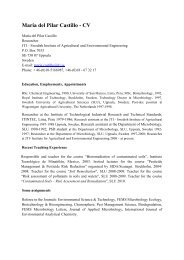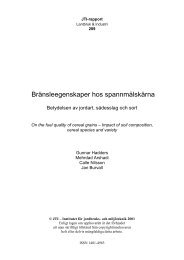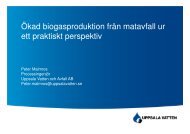Evaluation of JTI's R&D Activities 2005–2008 - Formas
Evaluation of JTI's R&D Activities 2005–2008 - Formas
Evaluation of JTI's R&D Activities 2005–2008 - Formas
You also want an ePaper? Increase the reach of your titles
YUMPU automatically turns print PDFs into web optimized ePapers that Google loves.
This decrease has had limited influence on the total budget<br />
<strong>of</strong> commissions from stakeholders. JTI has taken measures<br />
to increase its attractiveness to stakeholders and to find new<br />
stakeholders and clients in the field <strong>of</strong> environmental technologies<br />
(Action Plan for 2008).<br />
Development in yearly turnover<br />
The average yearly turnover in the period 2004 – 2007<br />
amounts to 28.9 M SEK, with a sharp decrease in the year<br />
2005 to a turnover <strong>of</strong> 24.7 M SEK, due to the difficulties in<br />
funding from industry resources. The yearly turnover shows a<br />
slight increase, but the increase is significantly lower than the<br />
target set for the different years. Base funding from <strong>Formas</strong><br />
and SJMF has increased in the evaluation period by approx.<br />
13 %. During 2004 –2007 base funding comprised 40 % <strong>of</strong><br />
JTI’s turnover.<br />
A comparison <strong>of</strong> the base funding <strong>of</strong> JTI with two other<br />
institutions in this area:<br />
• In the year 2006, base funding for the Applied research<br />
group “Plant and Environment” amounted to approx. 70 %<br />
(Ministry <strong>of</strong> Agriculture, Nature and Food Quality 40 %<br />
+ 30 % from Commodity Boards) with a yearly turnover<br />
<strong>of</strong> 41 M € ( part <strong>of</strong> Plant Sciences Group within Wageningen<br />
University and Research centre)*<br />
• A well known R&D institute in the area <strong>of</strong> Agricultural<br />
and Environmental Engineering in Germany has achieved<br />
an average 18 % <strong>of</strong> commissions, or in other words 82 %<br />
<strong>of</strong> the budget was financed by the national and regional<br />
governments. This means that, in comparison with the<br />
above institutes in Europe – and maybe also with SLU–<br />
the base funding <strong>of</strong> JTI is still very moderate to low.<br />
A remark can be made concerning the “base funding part”<br />
from SJMF which is used for projects, which, according to the<br />
definition <strong>of</strong> the financing <strong>of</strong> research, is not base funding.<br />
The number <strong>of</strong> stakeholders – as already mentioned – is<br />
declining by approx. 30 %. The breadth <strong>of</strong> the working areas<br />
<strong>of</strong> JTI is reflected in the breadth <strong>of</strong> the working fields <strong>of</strong> the<br />
members <strong>of</strong> SJMF. Especially for new developments it can be<br />
<strong>of</strong> value that the scoping studies or global surveys should be<br />
carried out as commissions from <strong>Formas</strong>.<br />
30<br />
<strong>Evaluation</strong> <strong>of</strong> JTI’s R&D <strong>Activities</strong> <strong>2005–2008</strong>


